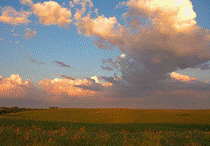
Proceedings of the North American Prairie Conferences
Date of this Version
1989
Document Type
Article
Abstract
Weeds are a major problem in seeding rangeland and cropland to native grasses. However, many immature weedy forbs and grasses are palatable to cattle. Research was conducted using yearling cattle for weed control in big bluestem (Andropogon gerardii var. gerardii Vitman) seedings (1987, 1988) at Mead, Nebraska on a Sharpsburg silty clay loam (fine, montmorillonitic, mesic Typic Argiudoll) soil. Prominent volunteer species were annual foxtails (Setaria spp. Beauv.), redroot pigweed (Amaranthus retroflexus SSL.), velvetleaf (Abutilon theophrasti Medic.), and common ragweed (Ambrosia artemisiifolia L.). Cattle consumed annual foxtails and redroot pigweed, but did not consume velvetleaf or common ragweed. Annual foxtails were grazed completely while heifers mainly stripped leaves and defoliated the tops of red root pigweed. Redroot pigweed and annual foxtails were randomly collected within blocks during both grazing seasons to quantify forage value. Foliage (upper stem and leaves) was analyzed for crude protein (CP), neutral detergent fiber (NDF), acid detergent fiber (ADF), and in vitro dry matter disappearance (IVDMD). Redroot pigweed foliage and leaves were analyzed for nitrate (N03). Crude protein levels of annual foxtails and redroot pigweed were never below nutritional requirements for heifers. Fiber (NDF and AD F) and IVDMD values were similar to early-vegetative smooth brome (Bromus inermis Leyss.) and early-bloom alfalfa (Medicago sativa L.). Nitrate concentration reached toxic levels (10,000 ppm N03) in redroot pigweed by mid-July, 1987. In 1988 nitrate levels exceeded the toxic level at the beginning of the grazing season. An abundance of forage nitrate accumulators in weedy vegetation limits grazing as a weed control practice. However, grazing may be an adequate weed control practice when the prominent weeds are annual grasses.


Comments
Published in Prairie Pioneers: Ecology, History and Culture: Proceedings of the Eleventh North American Prairie Conference, August 7-11, 1988, Lincoln, Nebraska (Lincoln, NE 1989).